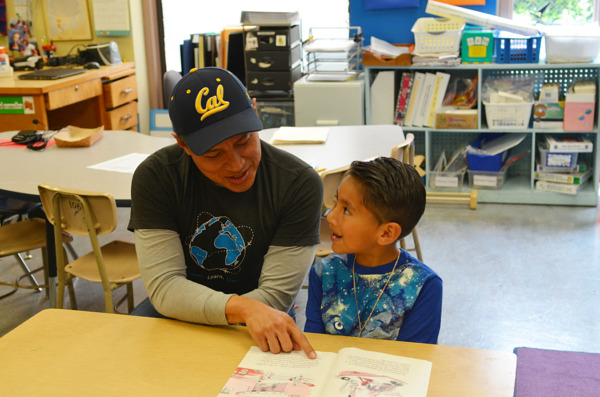
When volunteer Gerardo Chang Calderon walks into Junipero Serra Elementary School each week to tutor two students in literacy, the entire class says hello and waves to him eagerly.
In fact, it’s this enthusiasm that led Gerardo to actually retool the way he starts off his volunteer days. He used to ask his students, Matthew and Jonathan, who would like to read with him first. But after they started to compete for this particular honor, Gerardo decided to diplomatically switch off who gets to go first.
This week it’s Matthew’s turn. Matthew, a shyer student who nevertheless brightens up at the chance to spend time with Gerardo, begins to read aloud a book about firefighters. Gerardo interjects with questions about certain passages.
“What’s your favorite part?” he’ll ask, or “Think you might want to be a firefighter when you grow up?” His favorite part is when the book describes different types of firefighters, Matthew says, and no, he’d rather be a policeman. At the beginning of their half hour together they sometimes start in Spanish (by reading a “Jorge el Curioso,” or “Curious George” book, for instance) and then switch back to English. Or Matthew might ask a question in Spanish, to which Gerardo will occasionally respond in English.
“I wanted to put my bilingual background to use,” Gerardo says of his decision to start volunteering with the San Francisco Education Fund in 2011, first as an interpreter and now as a tutor in our Literacy Program. “It’s been very rewarding.”
The San Francisco Unified School District is made up of 27% English Language Learner students, and many of our teachers request bilingual volunteers. Volunteers who speak more than one language are invaluable for bilingual students in any subject area, and volunteers can support students as they learn a new language, navigate the education system or simply feel more comfortable in school.
Hilary Mason, who teaches the bilingual Spanish literacy pathway classroom where Gerardo dedicates his time, almost exclusively requests bilingual volunteers.
“The more volunteers that are in children’s lives, the more examples they have of why maintaining bilingualism is useful,” she says.
Multiple studies have shown that being bilingual can have positive effects on the brain – specifically the brain’s executive function, which controls multi-tasking, attention span and other important jobs. And Junipero Serra Elementary, which features dual-language programs that teach students in both English and Spanish, may be onto something. One study of students in dual-language programs in North Carolina during the 2009-10 school year found that these students scored higher on reading and math than students who were not in a dual-language programs. By middle school, two-way dual language students scored as high in reading and math as non-dual language students who were in the grade ahead of them, according to the study.
Ms. Mason’s bilingual volunteers often “understand what a child might be experiencing when they are reading in another language and what mistakes they might be making,” she says.
For example, Ms. Mason says one of her volunteers discovered his student was having trouble pronouncing Spanish diphthongs, in which a stronger and weaker syllable is combined into one sound. Being a native Spanish speaker both helped the volunteer detect the issue the student experienced and provide a way to correct it.
By recruiting more volunteers who are bilingual, we can also impact how children see their language skills, Ms. Mason says. Volunteers like Gerardo serve as incredible role models for students and can “celebrate their knowledge in their first language.”
Volunteers who are bilingual can also help students handle some of the trickier aspects of maneuvering between cultures. For example, Carmen Alonso, who volunteers in our College & Career Readiness Program and speaks Spanish, learned one of her students was spending nights after school helping her parents run their family restaurant, which did not leave her much time for extracurricular activities.
“I said to her, ‘You need to tell your mother and father that you want to go to university and that to do some sport is very important.” Carmen says. “The father finally said yes, and now she’s going to play soccer.”
One of Carmen’s 10th-grade students is considering studying design, while the other wants to go into nursing, Carmen says. But Carmen found out that the students were not aware, for example, of the advanced placement classes they could take or what kinds of summer opportunities were out there.
“They don’t know what’s available to them,” Carmen says. “They don’t know how the system works, and to have it explained to them in their language is a way to help them understand it.”
“The fact that we can communicate with them in their own language is crucial,” Carmen adds.
“I’m very aware of Latin American culture, and that puts people at ease,” Gerardo agrees. “I understand where they’re coming from. I think it allows me to jump into two worlds.”
If you’re bilingual or have any level of dual-language skills, our students and teachers need you! Sign up to volunteer and make a big difference in the life of a child.

